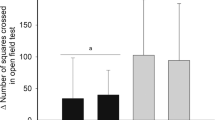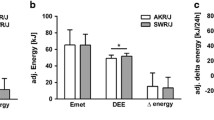Summary
The aim of this study was to examine the differences in physical activity and their contribution to differences in energy utilization in mice, selected either high or low for food intake, adjusted for body weight, which show correlated responses in lean content and metabolic rate. Simultaneous measurements of fasting metabolic rate and activity were made in lines of mice selected at either: a young age, 4-to 6-week food intake corrected for 4-week body weight; or an older age, 8- to 10-week food intake corrected for mean weight at 8 and 10 weeks of age. Correlated response in metabolic rate was found to have been accompanied by changes in locomotor activity near the ages at selection in both sets of lines. Activity, however, accounted for only a small proportion of variation in fasting heat production, generally less than 5%, although a highly positive correlation (r=0.63) between the two traits was found. It was concluded that selection for food intake adjusted for body weight has led to correlated response in physical activity. In consequence, mice selected in the upward direction expend some of the excess energy intake rather than assimilating it as body mass and are, therefore, slightly leaner than their counterparts selected in the downward direction.
Similar content being viewed by others
References
Anderson VN, Smith GK (1987) Effects of feeding and light cycles on activity rhythms of maternally isolated rat pups. Physiol Behav 39:169–181
Biondini PE, Sutherland TM, Haverland LH (1968) Body composition of mice selected for rapid growth rate. J Anim Sci 27:5–12
Bishop SC (1985) Genetic and metabolic aspects of growth and its components in mice. PhD thesis, University of Edinburgh
Bishop SC, Hill WG (1985) Effect of selection on growth, body composition and food intake in mice. 3. Correlated responses; growth, body composition, food intake and efficiency and catabolism. Genet Res 46:57–74
Boshouwers FMG, Nicaise E (1987) Physical activity and energy expenditure of laying hens as affected by light intensity. Br Poult Sci 28:155–168
Dauncey MJ (1986) Activity-induced thermogenesis in lean and genetically obese (ob/ob) mice. Experientia 42:547–549
Halter HM, Wenk C, Schurch A (1980) Effect of feeding level and feed composition on energy utilization, physical activity and growth performance of piglets. In: Mount LE (ed) Energy metabolism. Proc 8th Symp Energy Metabolism, EAAP Publication No. 26, Butterworths, London
Harvey WR (1985) User's guide for LSMLMW, mixed model least-squares and maximum likelihood computer program. Ohio State University
Hastings IM, Hill WG (1989) A note on the effect of different selection criteria in mice. Anim Prod 48:229–233
Lynch CB, Roberts RC (1984) Aspects of temperature regulation in mice selected for large and small size. Genet Res 43:299–306
Macleod MG, Jewitt TR, White J, Verbrugge M, Mitchell MA (1982) The contribution of locomotor activity to energy expenditure in the domestic fowl. In: Ekern A, Sunstol F (eds) Energy metabolism of farm animals. Proc 9th Symp Energy Metabolism. EAAP Publication No. 29, pp 297–300
McNab BK (1988) Complications inherent in scaling the basal rate of metabolism in mammals. Q Rev Biol 63:26–53
Miller BG, Kirkwood JK, Howard K, Tuddenham A, Webster AJF (1981) A self-compensatory, closed-circuit respiration calorimeter for small mammals and birds. Lab Anim 15:313–317
Moruppa SM, Hill WG, Sinnet-Smith PA (1989) Effect of selection for growth, body composition and food intake in mice: utilization of increased energy intake by “cafeteria” feeding. Livestock Prod Sci (in press)
Mount LE, Willmott JV (1967) The relationship between spontaneous activity, metabolic rate and the 24 h cycle in mice at different environmental temperatures. J Physiol 190:371–380
Parker K (1988) Protein turnover in mice selected for appetite. PhD thesis, University of Edinburgh
Pym RAE, Farrell DJ (1977) A comparison of the energy and nitrogen metabolism of broilers selected for increased growth rate, food consumption and conversion of food to gain. Br Poult Sci 18:411–426
Pym RAE, Nicholls PJ (1979) Selection for food conversion in broilers: Direct and correlated responses to selection for body weight gain, food consumption and food conversion ratio. Br Poult Sci 20:73–86
Pym RAE, Solvyns AJ (1979) Selection for food conversion in broilers: Body composition of birds selected for increased body-weight gain, food consumption and food conversion ratio. Br Poult Sci 20:87–97
Sharp GL, Hill WG, Robertson A (1984) Effects of selection on growth body composition and food intake in mice. 1. Responses in selected traits. Genet Res 43:75–92
Simmel EC, Bagwell M (1983) Genetics of expolatory behaviour and activity. In: Fuller JL, Simmel EC (eds) Behaviour genetics; principles and application. Lawrence Erlbaum Associates, London, pp 89–113
Sutherland TM, Biondini PE, Haverland LH, Pettus D, Owen WB (1970) Selection for rate of gain, appetite and efficiency of feed utilization in mice. J Anim Sci 31:1049–1057
Trayhurn P, Thurlby PL, Woodward CJH, James WPT (1979) Thermoregulation in genetically obese rodents: the relationship to metabolic efficiency. In: Festing MFW (ed) Animal models of obesity. Macmillan, London, pp 191–203
Verstegen MWA, Van der Hel W, Brandsma HA, Kanis E (1982) Heat production of groups of growing pigs as affected by weight and feeding level. In: Ekern A, Sundstol F (eds) Energy metabolism of farm animals. Proc 9th Symp Energy Metabolism. EAAP Publication No. 29, pp 218–221
Author information
Authors and Affiliations
Additional information
Communicated by E. J. Eisen
Rights and permissions
About this article
Cite this article
Moruppa, S.M. Energy expenditure and locomotor activity in mice selected for food intake adjusted for body weight. Theoret. Appl. Genetics 79, 131–136 (1990). https://doi.org/10.1007/BF00223799
Received:
Accepted:
Issue Date:
DOI: https://doi.org/10.1007/BF00223799




